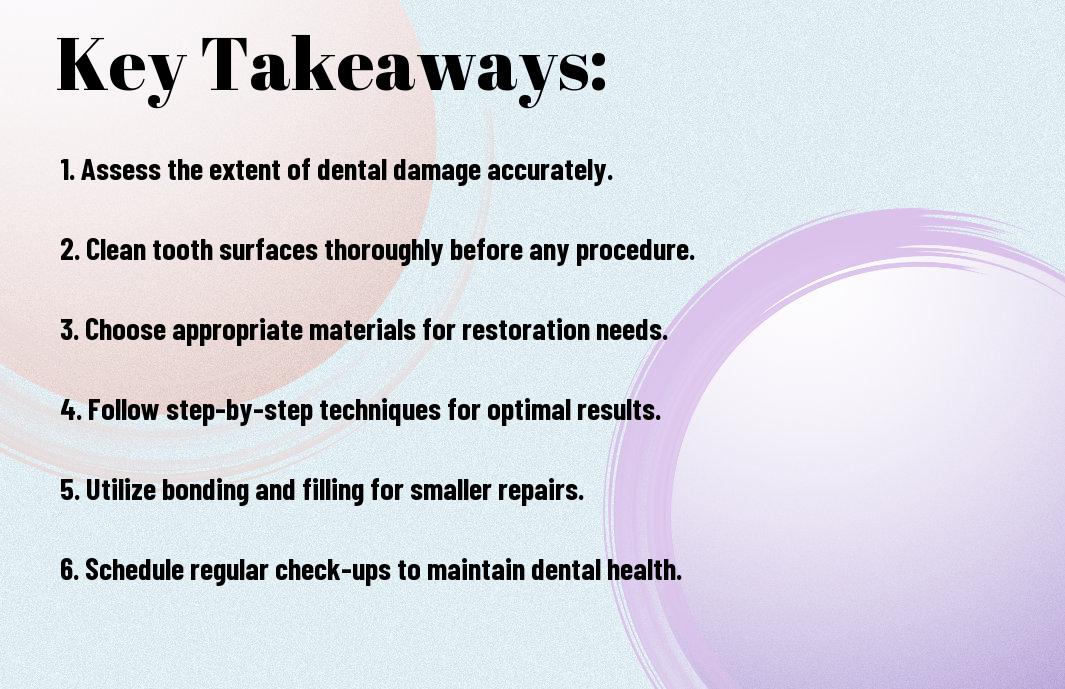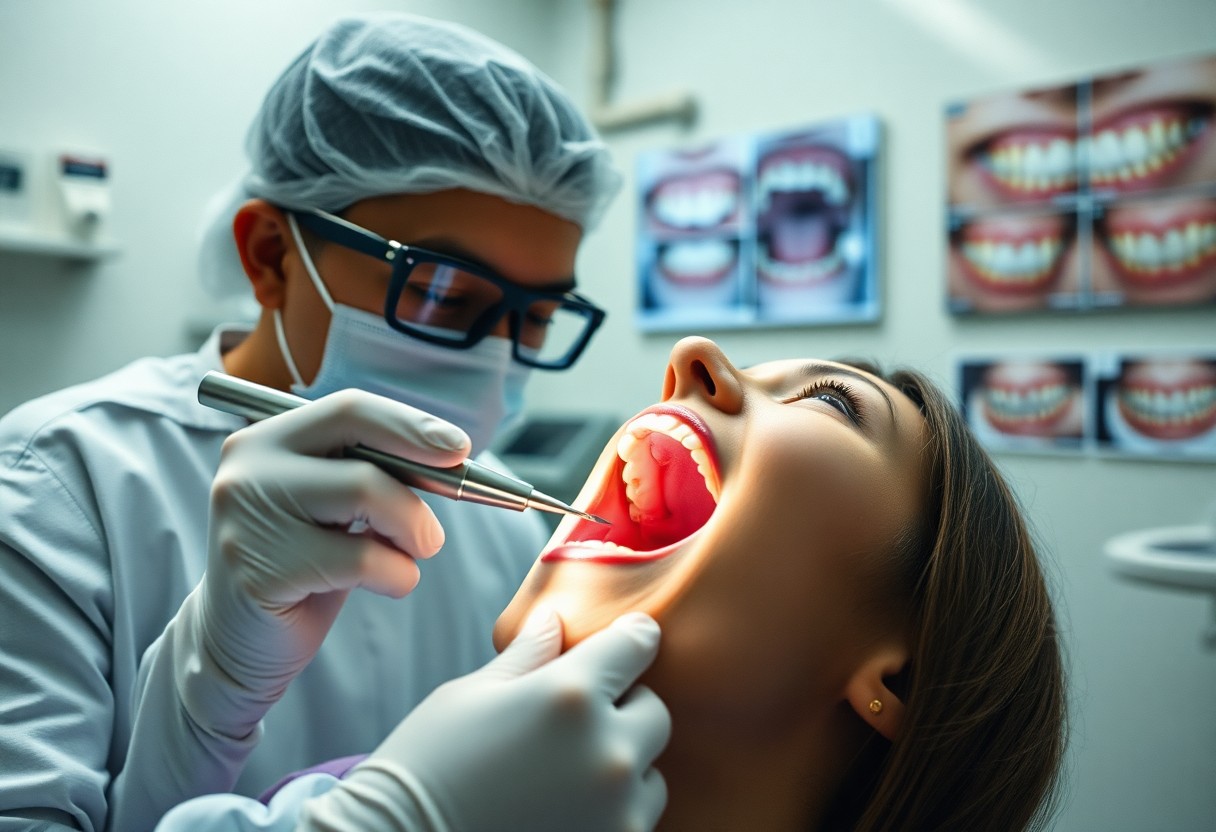Restorative Dentistry – 7 Steps To Repair And Renew Your Teeth
There’s a significant need to understand the principles of restorative dentistry if you’re looking to improve your dental health. I want to guide you through seven necessary steps that can help you effectively repair and renew your teeth. By following these steps, you can not only address existing issues but also enhance your overall oral health, boosting your confidence and ensuring a bright smile for years to come. Let’s explore how you can take control of your dental destiny today!
Key Takeaways:
- Assessment: The first step involves a thorough examination of your oral health to identify damaged areas.
- Diagnosis: Properly diagnosing the type of dental issues is necessary for developing an effective treatment plan.
- Treatment Planning: A customized plan will be created, outlining the procedures needed for restoration.
- Cleaning: Prior to any restorative work, professional cleaning of your teeth is important to remove plaque and tartar.
- Repair Options: Various methods such as fillings, crowns, or bridges will be selected based on individual needs.
- Follow-up Care: Post-treatment care is critical to ensure the longevity of restorations and maintain oral hygiene.
- Prevention: Emphasis on preventive measures will help in preserving dental health and reducing future issues.
Understanding Restorative Dentistry
Definition and Importance
For anyone grappling with dental issues, understanding restorative dentistry is key to achieving a healthier smile. This branch of dentistry focuses on repairing and restoring damaged teeth to enhance both functionality and aesthetics. I can assure you that restorative dentistry plays a vital role in not only improving your oral health but also boosting your overall confidence. When teeth are damaged due to decay, trauma, or wear, restorative procedures can help return them to their natural state, allowing you to enjoy your favorite foods and smile with ease.
Understanding restorative dentistry is necessary because the health of your teeth directly impacts your quality of life. When your teeth are compromised, it can lead to discomfort and more severe health issues, including gum disease and tooth loss. Therefore, investing in restorative methods is not merely about aesthetics; it’s about achieving long-term dental health.
Common Procedures in Restorative Dentistry
For those seeking solutions to their dental challenges, there are several common procedures within restorative dentistry that can effectively address your specific needs. These procedures often include fillings, crowns, bridges, dentures, and root canals, among others. I have found that each treatment option is tailored to restore your teeth’s function while also enhancing their appearance. For instance, fillings are frequently applied to repair cavities, while crowns help to strengthen and protect damaged teeth.
The landscape of restorative dentistry is rich with various methods designed to repair and renew your teeth. You might find yourself considering implants if you’re dealing with missing teeth, or veneers if you’re interested in improving your smile’s aesthetics. Each procedure showcases the incredible advancements in dental technology and techniques, allowing for nature-like results that can dramatically enhance your oral health and self-esteem. Ultimately, the right restorative option for you will depend on your dental condition, goals, and a thorough consultation with your dentist.

Step 1: Initial Consultation
Any successful restorative dentistry journey begins with an initial consultation. This is the first step that allows me to assess your oral health needs and discuss the best treatment options tailored for you. During this appointment, I will gather important information about your dental history, lifestyle, and any specific concerns you may have regarding your teeth. It’s a time for us to establish a rapport and ensure that you feel comfortable and informed about the process ahead.
Comprehensive Dental Examination
Comprehensive dental examinations are necessary for understanding your current dental condition. I will perform a thorough examination of your teeth, gums, and mouth, using advanced diagnostic tools such as digital X-rays and an intraoral camera. This step allows me to identify any underlying issues, such as cavities, fractures, or signs of gum disease that may not be immediately visible. By obtaining a complete picture of your oral health, I can make informed recommendations for your restorative treatment.
Discussion of Patient Concerns
Before proceeding with any treatment, I believe it is vital to have an open conversation about your concerns and expectations. Your input is invaluable in shaping a personalized treatment plan that meets your needs. During this discussion, I will encourage you to share any pain, discomfort, or aesthetic issues that may be bothering you, ensuring that we address all aspects of your oral health.
But let’s dive a bit deeper. This phase of the consultation aims to create a safe space where you can express your fears or anxiety about dental procedures. I want to hear about any past experiences that may have affected your perception of dental care. By understanding your perspective, I can provide reassurance and outline a treatment plan that not only addresses your dental needs but also prioritizes your comfort and peace of mind. Your voice matters, and it helps in crafting a rejuvenating and effective restorative experience.
Step 2: Diagnosis and Treatment Planning
After evaluating the current state of your teeth, the next step in restorative dentistry involves a comprehensive diagnosis and treatment planning process. I will meticulously assess your dental health using a combination of imaging techniques and visual examinations to identify any underlying issues. This stage is necessary to ensure that I can effectively address problems, whether they involve decay, fractures, or missing teeth. By understanding the specifics of your dental situation, I can present you with a clear overview of what needs to be done. For further insight into the necessarys of restorative dentistry, I recommend checking out Restorative Dentistry 101: Repair, Restore, Renew.
Identifying Issues
At this stage, I focus on pinpointing specific dental issues that may be compromising your oral health. I will conduct detailed examinations and possibly take X-rays, allowing me to see things that are not visible to the naked eye. Whether it’s cavities, gum disease, or issues with your bite, identifying these problems early could significantly enhance the effectiveness of your treatment plan. It is necessary to discuss any symptoms you’re experiencing, as the more information I gather, the better I can customize my approach. This collaborative effort ensures that none of your dental concerns go unnoticed.
Customizing the Treatment Plan
The next step involves tailoring a treatment plan that best suits your needs. Depending on the identified issues, I will outline various restorative options such as fillings, crowns, or implants, taking into account your preferences, budget, and overall health. This customized plan will serve as a roadmap for your dental treatment journey and will be designed to address both immediate concerns and long-term dental health.
And as I develop your treatment plan, I will emphasize the importance of ensuring that it aligns with your lifestyle and goals. It’s vital that you feel comfortable with the proposed solutions, and I will always encourage open dialogue throughout the process. This tailored approach not only aims to restore your smile but actively works towards improving your oral health in a sustainable manner, ensuring a positive and lasting impact on your daily life.
Step 3: Tooth Restoration Options
Keep in mind that the options available for tooth restoration can vary based on the extent of damage and individual dental health needs. I want to guide you through some of the most common methods used to restore your teeth effectively and safely. Each option has its own benefits and limitations, so let’s explore them together.
Fillings and Crowns
Tooth fillings are often the first line of defense when it comes to treating cavities or minor damage. They are typically made of composite resin, amalgam, or porcelain and are designed to blend in with your natural tooth structure. If you have a more significant amount of decay or damage, your dentist might recommend a crown, which encases the entire tooth. Crowns are usually made from porcelain, metal, or a combination of both and serve to protect the tooth from further harm while also restoring its function and aesthetics.
Bridges and Implants
Bridges provide an effective solution when you have missing teeth. They consist of two or more crowns on either side of the gap, supporting a prosthetic tooth in the middle. This option can help maintain your facial structure and prevent your remaining teeth from shifting. On the other hand, implants involve a surgical procedure where a dental implant post is inserted into your jawbone, serving as a foundation for a replacement tooth or bridge. This method not only restores the tooth at the surface but also contributes to overall jaw health.
Understanding the differences and benefits of bridges and implants is important for making an informed decision about your dental health. While bridges are typically quicker to install and may require less recovery time, implants offer a more permanent solution that can last for many years with the right care. Both options aim to enhance your smile and restore proper function, but I encourage you to discuss with your dentist which aligns best with your personal needs and conditions.

Step 4: The Restoration Process
Now that we have assessed your dental condition and determined the best course of action, the next phase is the restoration process. This step is vital as it encompasses the actual procedures used to repair your teeth. As we initiate on this journey, I’ll guide you through the vital stages that will help restore both functionality and aesthetics to your smile. The process involves careful, detailed work to ensure that your teeth regain their strength and look natural.
Preparing the Tooth
Around the restoration process, preparation of the tooth is an important step. This may include the removal of any decayed tissue and the shaping of the tooth to accommodate the restoration material properly. Your dentist will use specific instruments to clean the area thoroughly, ensuring that no debris or infection remains. A well-prepared surface is key to creating a strong bond between your natural tooth and the restoration.
Applying the Chosen Restoration
About halfway through the process, it’s time to apply the chosen restoration. Depending on your individual needs, this could involve fillings, crowns, veneers, or bridges. Each method has its own application technique, designed to enhance durability and aesthetics. I make sure that the materials I use are high-quality to provide you with long-lasting results.
Chosen carefully based on the specific needs of your dental situation, the restoration will be crafted to fit seamlessly with your existing teeth. The materials I opt for not only ensure that your smile looks great but also provide the strength needed to endure daily wear and tear. I pay special attention to the bonding process, as this is vital for both strength and longevity. By adhering the restoration properly, it contributes to a natural feel and function, allowing you to eat, speak, and smile confidently.

Step 5: Post-Procedure Care
Unlike the initial dental procedure, the post-procedure care plays a pivotal role in ensuring the longevity of your restorative work. It is vital to follow through with the care instructions provided by your dentist to facilitate a smooth recovery. Your ability to maintain oral hygiene and avoid certain behaviors for a designated period can significantly impact your healing process and the durability of the restoration you’ve received. Ignoring care guidelines could potentially lead to complications, including infections or even damage to your new restorations.
Recovery Guidelines
Between managing any discomfort and adjusting to your new restoration, it’s necessary to adhere to a specific set of recovery guidelines. This might include avoiding hard or sticky foods that could compromise your restoration, as well as steering clear of hot beverages while your mouth is still sensitive. Additionally, maintaining good oral hygiene while being mindful around the area of your procedure can help prevent unnecessary issues. You may also be advised to use a salt water rinse or an antiseptic mouthwash to keep your mouth clean and aid in the healing process.
Follow-Up Appointments
An important aspect of your post-procedure care involves attending follow-up appointments. These check-ups allow your dentist to evaluate the healing process and the integrity of your restoration. Skipping these appointments can result in missed issues or complications that may arise after the procedure, which could lead to more extensive and costly repairs later on. Your dentist may also use this time to make necessary adjustments to your restoration, ensuring it fits comfortably and functions effectively.
FollowUp visits are not just routine; they serve as an opportunity for me to assess the success of the procedure and ensure that your mouth is healing properly. The dentist can check for signs of discomfort, evaluate the alignment, and confirm that your restoration is responding well to your bite. It’s an important chance to discuss any concerns you might have, making sure I address any lingering questions about your recovery. By keeping these appointments, you help protect your investment in your dental health and ensure your smile remains bright and functional.
Final Words
Ultimately, understanding the seven steps to repair and renew your teeth through restorative dentistry can empower you to make informed decisions about your dental health. As I’ve outlined, the journey begins with a thorough assessment and includes tailored treatment options that fit your unique needs. With advancements in dental technology, the procedures available today are more effective and efficient than ever, allowing for a healthier mouth and increased confidence in your smile. By taking proactive measures, you can restore not just the function of your teeth but also their aesthetics.
I encourage you to explore your options further, especially when it comes to Choosing a Dental Restoration Procedure to Fix Your Teeth. Educating yourself about the available treatments will allow you to engage in meaningful conversations with your dentist and make choices that are right for you. Your dental journey is personal, and understanding these steps can lead to renewed health and well-being for your smile.
FAQ
Q: What is restorative dentistry?
A: Restorative dentistry is a branch of dental care focused on repairing and restoring the function and aesthetics of damaged teeth. This may involve a variety of dental procedures to address issues resulting from decay, injury, or wear, ensuring that both the health and appearance of the teeth are improved.
Q: What are the common procedures involved in restorative dentistry?
A: Common procedures include dental fillings, crowns, bridges, veneers, root canals, and dentures. Each of these procedures aims to restore the integrity of the teeth or replace missing ones, providing a functional and attractive smile.
Q: How do I know if I need restorative dentistry?
A: Signs that you may need restorative dentistry include persistent tooth pain, visible decay, chipped or broken teeth, loose teeth, or difficulty chewing. If you notice any of these issues, it’s advisable to consult your dentist for a proper evaluation and recommendations.
Q: What are the benefits of restorative dentistry?
A: The benefits of restorative dentistry include improved oral function, enhanced appearance, prevention of further dental issues, and increased self-confidence. By addressing damaged teeth, restorative procedures can contribute to better overall health and quality of life.
Q: How long do restorative dental treatments last?
A: The longevity of restorative treatments varies depending on the procedure and individual care. For example, fillings can last several years, while crowns may last 10-15 years or longer with proper maintenance. Regular dental check-ups and good oral hygiene practices play a significant role in the durability of these treatments.
Q: Is restorative dentistry painful?
A: Most restorative dentistry procedures are performed with anesthesia to minimize discomfort. While some patients may experience mild sensitivity after treatment, significant pain is uncommon. Your dentist will discuss pain management options and aftercare to enhance comfort during recovery.
Q: How can I care for my teeth after restorative treatments?
A: Post-treatment care involves maintaining good oral hygiene through regular brushing and flossing, avoiding hard or sticky foods that could damage the restoration, and scheduling routine dental check-ups. Following your dentist’s recommendations will help ensure the success and longevity of restorative work.




